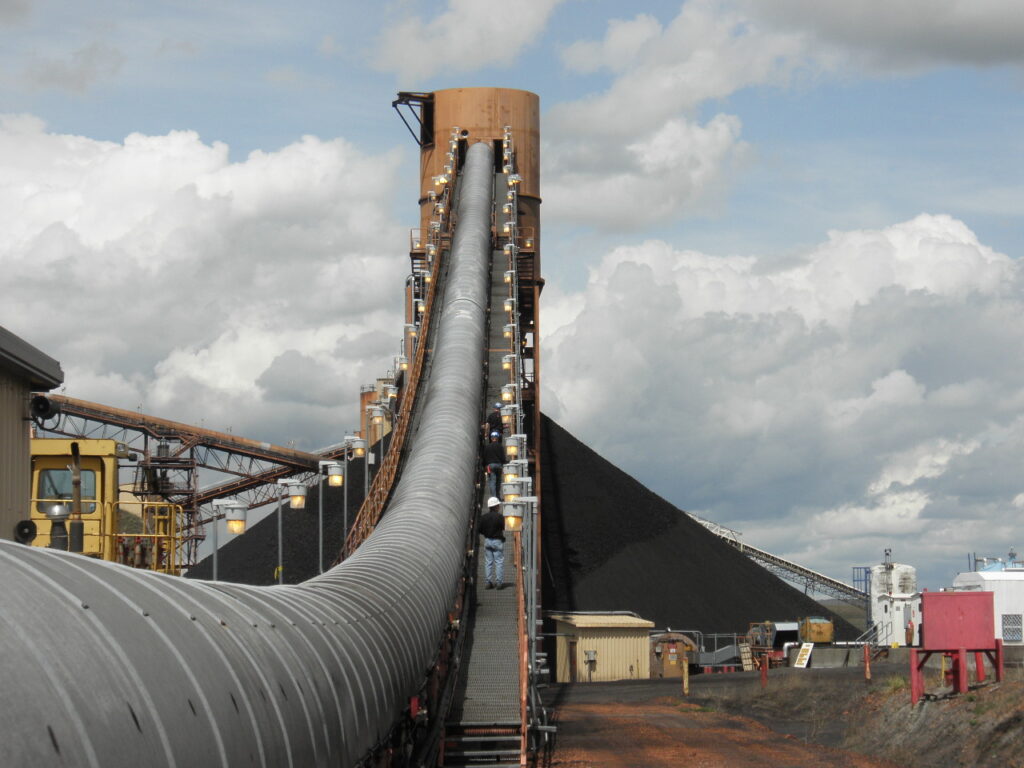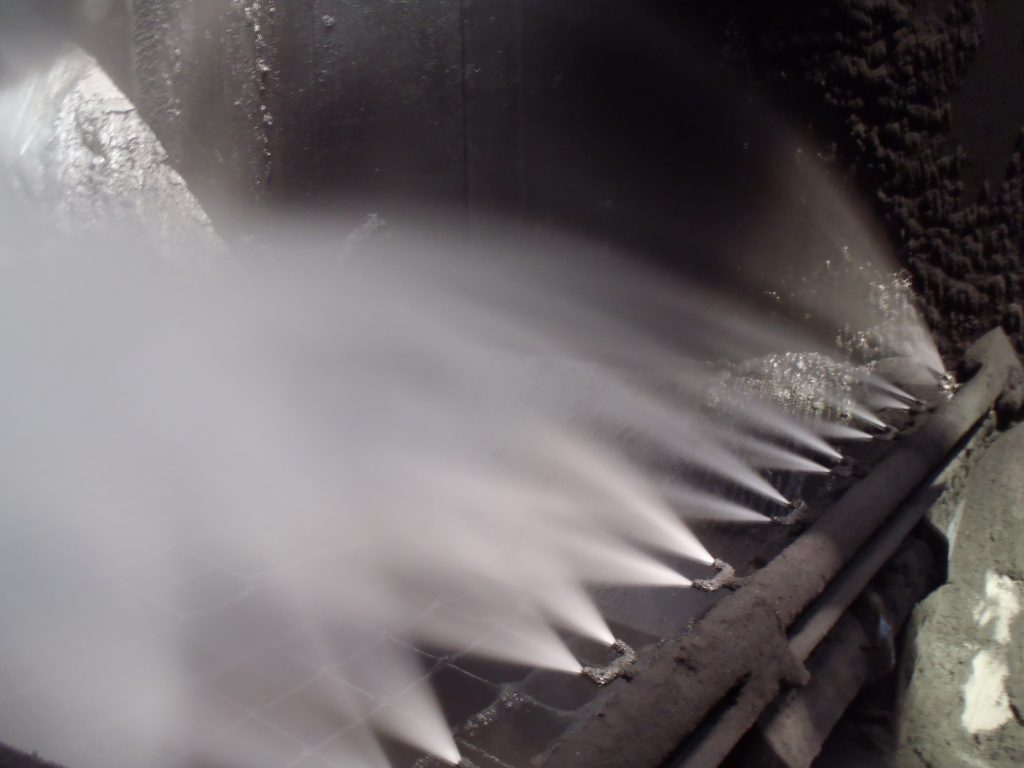Dust: It’s an ever-present concern for bulk material handlers, especially those that work with crushed, fine, or powdered materials.
As it applies to bulk material handling, dry, solid dust is classified according to its particle size. Different sources vary in their classifications, but almost all group the particles based on diameters of 10 micrometers (μm) or smaller.
According to the EPA, inhalable particles are between 2.6 and 10 μm in diameter. Fine inhalable particles, the most dangerous to health, are 2.5 μm and smaller. By comparison, a human hair is about 70 μm in diameter – around 30 times the size of a fine inhalable particle.

Inhalable dust can lodge in the nose, throat, or upper respiratory tract. Fine inhalable dust can penetrate the body’s built-in cleaning mechanisms (e.g., mucus membranes) and travel deep into the bloodstream as well as the lungs, where they are likely to remain. Consistent exposure to inhalable and fine inhalable dust can irritate airways, aggravate allergies and respiratory problems, and even lead to lung disease.
Beyond its threats to personal health, fugitive dust can damage equipment, create fire hazards, and cause expensive, time-consuming maintenance. It can also travel into the community where an operation is located.
Sources and Causes of Airborne Dust Particles
Rising awareness and stricter safety standards have driven improvements in controlling dust at bulk material handling facilities. However, while equipment and technology have helped make conditions safer than before, controlling dust remains a daily challenge for operators. This is because just about any activity that disturbs bulk material generates dust, especially from crushed, fine, or powdered materials.
Factors ranging from a worn conveyor to wind erosion can create airborne dust particles. Adding to the challenge, airborne dust particles can escape during many different materials handling procedures. Just a few include:
- bulk storage
- grinding
- conveying
- loading & unloading
- crushing
- material weighing
- dumping
- mixing & blending
- feeding
- reducing size

Deciding on a Dust Control System
Fugitive dust control becomes a matter of objective and strategy for each operation. For example, is dust management at a plant calling for controlling dust after its release from the material flow or influencing particle size, cohesion, and air velocity?
Plant managers will focus on every source and cause of dust at their particular plant in developing dust management. Dust-control variables can be dynamic because of changes in environment, material, or procedure. Equipment that has been modified also may impact dust creation. The following sections will address factors for assessing and controlling fugitive dust.
Temperature
High temperatures can contribute to fugitive dust. Bulk material handling’s many moving parts create constant friction, which in turn produces heat. Within pneumatic systems, the pressure of moving air inside tubes and pipes can raise temperatures as well.
Metals exposed to intense heat for long periods will expand and contract, making them bend, crack, stick, or misalign. This can then affect gears, motors, and conveyors, and thus material flow. As a result, the product can clog, lump, and struggle to move through hoppers and filters.
For this reason, monitoring and controlling temperature should be part of a facility’s dust management.
Combustible Dust
Certain types of fugitive dust can become combustible as they accumulate in the air. OSHA defines combustible dust as “fine particles that present an explosion hazard when suspended in the air in certain conditions.”
Combustible dust explodes when it reaches a high concentration in an enclosed area where heat and oxygen are present. The resulting pressure ignites the detonation. Beyond its potential harm to personnel, a combustible-dust explosion can significantly damage equipment. The first blast also can trigger one or more secondary explosions.
Combustible dust can become a concern where bulk material is processed for agriculture, biomass, fertilizer, paper and pulp, and coal industries. Therefore, assessment and control of combustible dust are vital to a dust control system.
Controlling Dust: Hood, Ductwork, and Air Velocity
Located at the discharge of the loading conveyor, the collection hood is where a dust control system starts by reducing the expansion of the material stream and deflecting it downward.
A hood with a peaked design can significantly limit escaped material and dust settling. However, the hood should also have proper airflow circulation and capture velocity (speed of the air at the hood opening) to overcome opposing air currents and capture airborne dust to flow into the hood. Capture velocities in the hood area should be 200–250 feet per minute.
A proper flow pattern and capture velocity will control dust without collecting excess amounts. If the capture velocity is too high, too much particulate matter will enter the dust collector toward the filters, which will endure heavy dust loading.
Continuing from the hood, the ductwork is the road system for dust collection and management. Ducts should be the proper size with a straight run of eight-inch diameters to ensure evenly distributed dust and air.
If ducts are too small, they will increase air velocity and quicken wear on the ducts. If they are too big, they will slow air velocity. This allows dust to gather and settle in the ducts, resulting in a dust control system with airflow and air-velocity problems and extra maintenance.
The proper air velocity in ductwork for dust collection in most bulk material handling applications is typically between 3500 and 4000 feet per minute.
Controlling Dust: Fan
The fan provides energy to the dust control system. Because the fan’s size determines the air volume, bulk material handlers will ensure it is correct. If the fan is too small, it will produce excessive air volume that stresses the system. Conversely, if the fan is too big, it will generate less air volume than needed, allowing dust to interfere with the system.
Controlling Dust: Blast Gate Dampers
Blast gate dampers are gate valves installed to ensure dust control system balance. They help control the airflow within the system, provide correct airflow rates, and close ducts when a system’s design needs more airflow to another part of the system.
Controlling Dust: Moisture
The addition of moisture to dust can be a highly effective form of dust suppression, mainly where fabric filters and combustible dust are involved.
The usage of controlled amounts of water on dust particles increases their size and weight, forcing them to settle before concentrating in the air. A wet dust extraction system uses energy generated by a bifurcated fan to encapsulate dust particles into atomized water droplets. The key to using moisture as a control measure is determining how much a material can absorb before it encounters thermal penalties and quality loss.
When adding moisture alone to dust may not control it properly, dust control chemicals offer another form of effective dust suppression. Encrusting, residual, foam, and wetting agents enhance water droplets’ ability to adhere to and increase the mass of material particles.

Controlling Dust: Filter Media
A dust control system’s equipment can be just right, but performance will be restricted if the system does not have the correct filter cartridges. Proper filters will capture the most airborne dust and then release it into a collection hopper.
Filter cartridges also must have the right media for a bulk material handling application. The wrong media can result in more significant dust hazards as well as higher energy usage.
Different filter media are available for different dust types: fibrous, flammable, toxic, sticky, and statically charged.
Controlling Dust: System Design
Ultimately, a system must have the proper overall design for an operation’s dry dust collection to achieve lasting fugitive dust control that protects personnel and equipment. One such system is Benetech’s MaxZone® Modular Skirtboard and Belt Support System for load zone containment dust control.
The MaxZone system’s design leaves no source of dust beyond its range of control by including components for every source of dust in the load zone:
- MaxZone XN Externally Adjusted Internal Wearliner for sealing the system and extending the life and production of chute work
- Sealing System with no-hassle clamps and seals on the sides of the load zone to contain dust and eliminate spillage
- Warrior Impact Bed with a stiff, rigid frame and soft rubber bars to cushion and absorb impact on the conveyor belt during loading
- Warrior Roll & Guide Support Bed with low-friction slider bars on the wing section and rollers in the center to create a seamless seal against load zone spillage and dust
- Simple Slide Idler for roller frames that slide into place close together without the need to remove adjacent idlers even in confined spaces, providing superior belt support with safe, easy maintenance
- Primary and Secondary Belt Cleaners (Scrapers) for resolving carryback issues
- Easy-Change Dust Curtain that interrupts airflow and lets the dust settle on the belt
- Unique Peaked Hood Design for greater containment of escaped material and less settling of dust
- Tailseal with skirting and strip rubber that creates a tight seal at the rear of the chute work
Benetech: Your Partner in Powerful Dust Control
Benetech dedicates its resources to making bulk material handling plants more compliant, safe, and productive. We are always ready to support you in developing a dust control system specific to your operation. If you would like to discuss dust control further or schedule a dust collection assessment, contact us at (630) 844-1300 to speak with a specialist.
Posted in Dust Control, Fugitive Dust Emissions, and Material Handling
